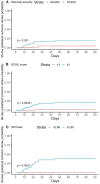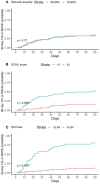Role of plaque inflammation in symptomatic carotid stenosis
- PMID: 36761341
- PMCID: PMC9902904
- DOI: 10.3389/fneur.2023.1086465
Role of plaque inflammation in symptomatic carotid stenosis
Abstract
Objective: Prior studies have shown that plaque inflammation on FDG-PET and the symptomatic carotid atheroma inflammation lumen-stenosis (SCAIL) score were associated with recurrent ischemic events, but the findings have thus far not been widely validated. Therefore, we aimed to validate the findings of prior studies.
Methods: A single-center prospective cohort study that recruited patients with (1) recent TIA or ischemic stroke within the past 30 days, (2) ipsilateral carotid artery stenosis of ≥50%, and (3) were not considered for early carotid revascularization. The (1) maximum standardized uptake value (SUVmax) of the symptomatic carotid plaque, (2) the SCAIL score, and (3) stenosis severity of the symptomatic carotid artery were measured for all patients. The outcomes were (1) a 90-day ipsilateral ischemic stroke and (2) a 90-day ipsilateral symptomatic TIA or major adverse cardiovascular event (MACE).
Results: Among the 131 patients included in the study, the commonest cardiovascular risk factor was hypertension (95 patients, 72.5%), followed by diabetes mellitus (77 patients, 58.8%) and being a current smoker (64 patients, 48.9%). The median (IQR) duration between the index cerebral ischemic event and recruitment to the study was 1 (0, 2.5) days. The median (IQR) duration between the index cerebral ischemic event and FDG-PET was 5 (4, 7) days. A total of 14 (10.7%) patients had a 90-day stroke, and 41 (31.3%) patients had a 90-day TIA or MACE. On comparison of the predictive performances of the SCAIL score and SUVmax, SUVmax was found to be superior to the SCAIL score for predicting both 90-day ipsilateral ischemic stroke (AUC: SCAIL = 0.79, SUVmax = 0.92; p < 0.001; 95% CI = 0.072, 0.229) and 90-day TIA or MACE (AUC: SCAIL = 0.76, SUVmax = 0.84; p = 0.009; 95% CI = 0.020, 0.143).
Conclusion: Plaque inflammation as quantified on FDG-PET may serve as a reliable biomarker for risk stratification among patients with ECAD and recent TIA or ischemic stroke. Future studies should evaluate whether patients with significant plaque inflammation as quantified on FDG-PET benefit from carotid revascularization and/or anti-inflammatory therapy.
Keywords: atherosclerosis; carotid stenting; endarterectomy; patient selection; stroke.
Copyright © 2023 Zheng, Lim, Tan, Chan, Paliwal, Jonathan, Bharatendu, Chan, Yeo, Vijayan, Hong, Chee, Wong, Chen, Chong, Dong, Tan, Sunny, Teoh, Sinha and Sharma.
Conflict of interest statement
The authors declare that the research was conducted in the absence of any commercial or financial relationships that could be construed as a potential conflict of interest.
Figures


Similar articles
-
Association of Plaque Inflammation With Stroke Recurrence in Patients With Unproven Benefit From Carotid Revascularization.Neurology. 2022 Jul 12;99(2):e109-e118. doi: 10.1212/WNL.0000000000200525. Epub 2022 Apr 13. Neurology. 2022. PMID: 35418461
-
Carotid Plaque Inflammation Imaged by PET and Prediction of Recurrent Stroke at 5 Years.Neurology. 2021 Dec 7;97(23):e2282-e2291. doi: 10.1212/WNL.0000000000012909. Epub 2021 Oct 5. Neurology. 2021. PMID: 34610991
-
A Risk Score Including Carotid Plaque Inflammation and Stenosis Severity Improves Identification of Recurrent Stroke.Stroke. 2020 Mar;51(3):838-845. doi: 10.1161/STROKEAHA.119.027268. Epub 2020 Jan 17. Stroke. 2020. PMID: 31948355 Clinical Trial.
-
Emerging Role of Carotid MRI for Personalized Ischemic Stroke Risk Prediction in Patients With Carotid Artery Stenosis.Front Neurol. 2021 Aug 3;12:718438. doi: 10.3389/fneur.2021.718438. eCollection 2021. Front Neurol. 2021. PMID: 34413828 Free PMC article. Review.
-
Contemporary carotid imaging: from degree of stenosis to plaque vulnerability.J Neurosurg. 2016 Jan;124(1):27-42. doi: 10.3171/2015.1.JNS142452. Epub 2015 Jul 31. J Neurosurg. 2016. PMID: 26230478 Review.
Cited by
-
Estimating inflammatory risk in atherosclerotic cardiovascular disease: plaque over plasma?Eur Heart J Cardiovasc Imaging. 2025 Mar 3;26(3):444-460. doi: 10.1093/ehjci/jeae314. Eur Heart J Cardiovasc Imaging. 2025. PMID: 39657321 Free PMC article. Review.
-
Imaging Carotid Plaque Inflammation Using Positron Emission Tomography: Emerging Role in Clinical Stroke Care, Research Applications, and Future Directions.Cells. 2023 Aug 15;12(16):2073. doi: 10.3390/cells12162073. Cells. 2023. PMID: 37626883 Free PMC article. Review.
-
Elevated high-sensitivity C-reactive protein levels are associated with intracranial arterial stenosis in elderly patients.BMC Neurol. 2025 Apr 30;25(1):189. doi: 10.1186/s12883-025-04208-2. BMC Neurol. 2025. PMID: 40307737 Free PMC article.
-
Residual Traditional Risk in Non-Traditional Atherosclerotic Diseases.Int J Mol Sci. 2025 Jan 10;26(2):535. doi: 10.3390/ijms26020535. Int J Mol Sci. 2025. PMID: 39859250 Free PMC article. Review.
References
LinkOut - more resources
Full Text Sources
Miscellaneous

